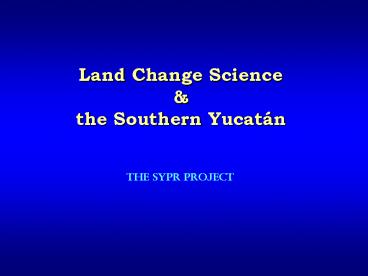Land Change Science - PowerPoint PPT Presentation
1 / 46
Title: Land Change Science
1
Land Change Science the Southern Yucatán
The SYPR Project
2
SYPR on the WWW http// earth.clarku.edu/lcluc
Principal sponsorship
Biocomplexity HSD program
NASA-LCLUC NSF-CISHDGE
3
PIs/Senior Scientists ----------------
Doctorates/Theses ------------------- Grad.
Ecology ----------------- Phys./remote
sensing GIS/human geography ----------- Econ
Social Science
4
Why the Southern Yucatán
- Final frontier of tropical forest in México
- 50 years of economic extraction, settlement,
development programs - Designated hot spot of tropical deforestation
- Largest tropical forest biosphere reserve in
México - Calakmul
- El Mundo Maya archaeo-eco-tourism
- Mesoamerican Biological Corridor
- Juxtapose the needs to cut and maintain forest
5
East-West borders coincide with ca. 100 m amsl
North-South borders coincide with CBR 900-1400
mm rf gradient
6
900 mm
350 m
Ecocline
1400 mm
7
Up-wet/soils/water stress
8
Seasonal Tropical Forest
9
Large Sites
Xpujil
Hormiguero
Chicana
10
Central Maya Lowlands Landscape, circa AD 850
Managed forest
Minor center
Farmsteads
11
Forest Returns
Hans Vester
12
Maya Impacts on Forest
Brosimum alicastrum L. ramón
13
Before 1960-Study Region Logging, 1900-1930
26,400 mahogany trees (70,400 m3) Logging,
1930-1960 93,633 mahogany trees (250,000 m3)
Peter Klepeis
14
Major Immigration 1967 thru 1985
S. Ochoa
bosque mediano
new cut
succession
15
Land Tenure and Ejidos SYPR Sample ejido area
18,703 km2
19 00
19 00
N
25 KM
LEGEND
Ejido
18 30
Forest amplifications
to outside SYPR
ejidos
Private
National
Ejidos in sample
18 00
89 30
90 00
90 30
89 00
16
Filling in the Region
17
SYPR 1 Survey
Invasive spp.
Dos Lagunas N
Instituions-fragmentation
Chili 1
El Refugio
Womens groups
Nuevo Becar
Chili 2
Xbonil
Valentin Gomez Farias
Silvituc
Alvaro Obregon
Nicolas Bravo
Km 120
La Lucha
Gustavo Diaz Ordaz
Centauros del Norte
Manuel Castillo Brito
20 de Noviembre
Polo Norte
La Guadalupe
Narciso Mendoza
Cristobal Colon
Tomas Garrido
El CIvalito
Arroyo Negro
18
HH Ejido Characteristics
Colin Vance
- Phase 1 Example results from multi-ejido survey
- 40 from Yucatan Pen. 41 Gulf Coast 4
Michoacan - Ave. resident time ? 19.4 yrs
- HH size 6.4 (vs. 4.6 nationally)
- Ave. swidden area 4.6 ha
- 12 HH ? some level remittances
- Ave. PROCAMPO payments N2,050
- 52 hh grow commercial chili 92 in zonas
chileras
Peter Klepeis
R. Roy Chowdhury
J. Geoghegan
19
Calakmul Biosphere Reserve
Established 1989 UN accepted 1993
R. deFries
20
Biological Corridors
Jan Dempewolf
Andy Hansen
21
EL Mundo Maya
22
Chile/Chili
E. Keys
Eric Keys
Capsicum annuum L. Jalapeño
23
(No Transcript)
24
- Phase 2 Example Results
- Commercial chili
- 92 hh in zonas chileras engage commercial chili
- markets controlled by coyotes intermediaries
- Women participation in green activities
- to increase hh income
- learn organization-social capital
- Green-sedentary initiatives
- minimally affect basic hh land use
- viewed locally as redistribution rights
- Intensified cultivation increased frequnecy
- Land rich hh abandoned fern-invaded crop land
- Household life cycles affect land use
- Increasing polarization of ejidos focused on
chili and male labor migration
Laura Schnieder
Eric Keys
Claudia Radel
Birgit Schmook
F. Gurri
25
TM Imagery Analysis, GIS and the Regional
Conditionrelevant for human side of land
change and leading to empirical diagnostic models
B. Schmook
R. Palmer
S. Cortina Villar
Yelena Ogenva-H.
J. Rogan
Laura Schneider
P. Macario M.
R. Eastman
Rinku Roy Chowdhury
26
(No Transcript)
27
uncertainty analysis in a step-wise process of
land-cover class discovery
28
Selva Mediana
29
(No Transcript)
30
CBR SY ecocline?
31
Spatially explicit econometric models
DEPENDENT VAR AGENCY-BASED MODEL STRUCTURE-BASED MODEL JOINT STRUCTURE-AGENCY MODEL
Milpa R20.6387 Entitlement Family size R20.5577 PROCAMPO R20.8625 Tenancy Labor/Consumer ratio
Spatially explicit agent-based assessment models
32
Lawrence et al. 2004
Phase 3 Integration Step 1 Vulnerability Couple
Human- Environment System
33
(No Transcript)
34
? Area Intensity of Deciduousness
Selva Baja Mediana Subcaducifolia
R. Eastman, R. Dickson, F. Sangermano, B. Schmook
35
? Surface Temperature
1
2
R. Eastman
36
R. Eastman
Profile 1
? Surface Temperature
N. Malizia
Temperature anomalies following arrows on
preceding map Distance - m
Profile 2
37
R. Eastman
Notice halo (yellow) surrounding cultivated land
(brown) extending 180-240 m into tree growth
? Surface Temperature
38
High frequency
Low frequency
39
Bracken Fern Invasion
? Fire Scare Burn Frequency
Bracken Fern
1985 ? 15 km2
1994 ? 40 km2
2001 ? 75 km2
5 km2
L. Schneider
40
D. Lawrence, Diekmann others
41
R. Roy Chowdhury L. Schneider
42
Selva Mediana Critical ecotone element
Vester et al.
? Landscape Level Biotic Diversity
43
(No Transcript)
44
(No Transcript)
45
(No Transcript)
46
Funding Sources
- Overall Project
- NASA - LCLUC Program
- ECOSUR
- Center for Integrated Studies, Carnegie Mellon
University (NSF) - NSF Biocomplexity
- Ecological Research
- Harvard Forest
- Conservation Research Foundation
- NSF Environmental Biology
- CONABIO CONACYT
- Modeling Research
- Center for Integrated Studies, Carnegie
- Mellon University
- NASA New Investigator Fellowship
- Linked Research
- NASAs Comparative Reserves-Park Study Montana
St. U-UMD)































